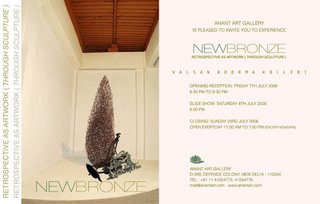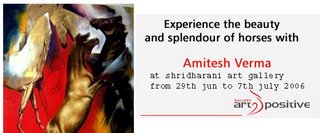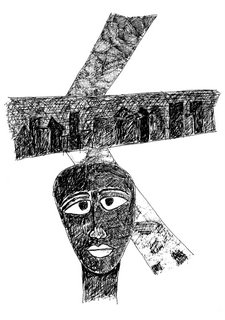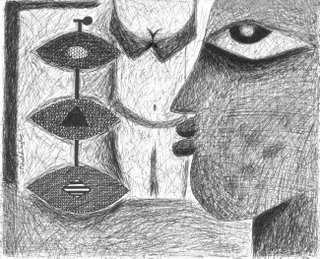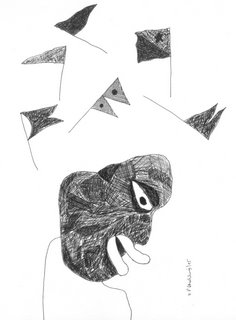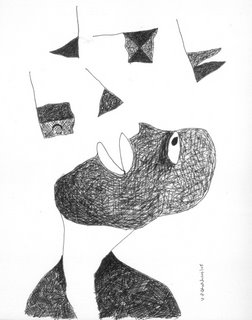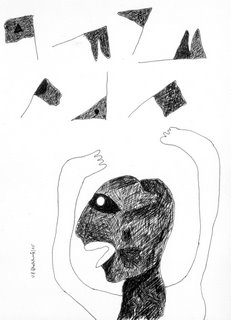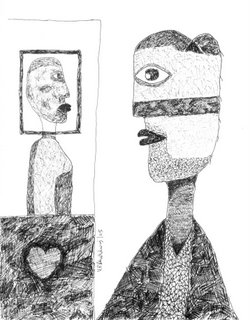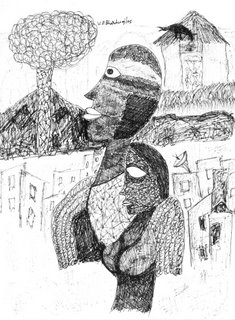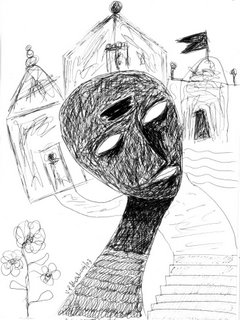vedart
art news and views for art lovers. editor : vedprakash bhardwaj, an artist, art writer and curator. To become a registered member and receive weekly updates please send your email address to vednet0512@yahoo.com
Sunday, June 25, 2006
Impressionist & Modern Art at Sotheby's Raised $201M
Impressionist & Modern Art at Sotheby's Raised $201M
artsaily.com, 24th june 2005
 Pablo Picasso, Le Peintre et Son Modele, Sold for £7,400,000. Copyright in this image shall remain vested in Sotheby’s.
Pablo Picasso, Le Peintre et Son Modele, Sold for £7,400,000. Copyright in this image shall remain vested in Sotheby’s.LONDON, ENGLAND.- Sotheby’s London June Impressionist and Modern Art series of sales came to a close, raising a record £109,391,640 ($201,813,944), which is the highest total for any series of auctions ever held in London. The sales saw competitive bidding throughout from buyers as far afield as Russia, the Middle and Far East, as well as from the traditional buying centres of Europe and the United States, eager to secure masterworks by some of the greatest artists of the Impressionist and Modern era. Melanie Clore, Deputy Chairman, Sotheby’s Europe and Co-Chairman Worldwide, Sotheby’s Impressionist and Modern Art Department, said: “The two days of sales sale provided unequivocal evidence that the London market is as strong as it has ever been. Bidding was from every corner of the world, with new buyers vying vigorously with long-standing clients. We had carefully choreographed the sales in response to the current strength of the market and we were thrilled to see our efforts so well received.”
The Impressionist and Modern art series comprised three sales: The Evening sale which totaled £88,774,400, The Works on Paper sale which totaled £6,928,440 and The Day sale which totaled £13,688,800. 20 lots sold for over £1 million / 30 lots sold for over $1 million. 2006 has been a phenomenal year for Sotheby’s Impressionist and Modern sales. In February our London sales raised £89 million and in May, our sales in New York totaled $248 million and saw Picasso’s portrait of Dora Maar au chat fetch an exceptional $95.2 million, the second highest price ever paid at auction for any painting. Sotheby’s holds the auction records both for the most expensive Impressionist painting (Picasso’s Garcon a la Pipe, $104.2 million) and work on paper (Degas’ Danseuse au repos £17.6 million). Sotheby’s also holds the highest auction prices for a German work of art ($22.6 million for Max Beckmann’s Selbstbildnis mit Horn) as well as an Austrian work of art.
Friday, June 23, 2006
Flaunt your artist upfront : RANA SIDDIQUI , The Hindu, 23 jun 2006
Flaunt your artist upfront : RANA SIDDIQUI , The Hindu, 23 jun 2006
 a teeshirt printed with neeraj goswami's painting
a teeshirt printed with neeraj goswami's painting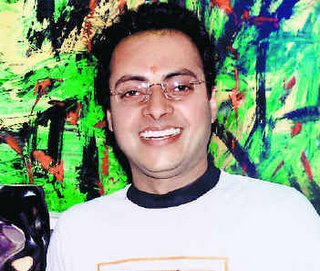 Wear a shirt, advocate a cause. That is Prince Singhaal's formula as he blends art with a social purpose.
Wear a shirt, advocate a cause. That is Prince Singhaal's formula as he blends art with a social purpose.
ART IN MY HEART Prince Singhaal and Neeraj Goswami's creation on a T-shirt. Prince Singhaal is at it again, with an additional `a' to his surname. The young man who is seen at all important social events, has now thought of a new idea to promote creations of contemporary artists. This time you have works of the likes of Jogen Choudhary, Bose Krishnamachari, Paresh Maity, Jai Zarotia, Gopi Gajwani, G.R. Santosh, Harshwardan, Suhas Roy, Shanti Dave, Shamshad Husain, Laila Khan Rajpal among 22 artists who have their creations printed on white cotton/ polyester mixed T-shirts. "I have also mixed lycra in the fabric to keep it upmarket. Some of the tee's are printed in Singapore," says Singhaal.
He has divided the artists into senior and junior categories. For senior artists like Paresh, Bose, Jogen he has kept the price at Rs.1200 and for junior ones as Laila Khan and G.R. Santosh's son Shabbir, at Rs.600. And if you want these T-shirts with the signature of the artists themselves, you have to shell out an additional Rs.5000 for senior artists and Rs.2000 for junior ones. Singhaal will take these collections to Mumbai, Kolkata, Hyderabad and Bangalore also.
"Those who can't afford expensive paintings of contemporary artists would at least be able to make a fashion statement and keep these T-shirts as memorabilia," he reasons.
Another way of making money through art and riding on the ever-confused psychology of the neo-art lovers? Or pandering to people for whom art is more a means to flaunt their possessions than a passion?
No joke this
Singhaal objects, "Absolutely not. The sales from the proceeds of these shirts will go towards the Campaign Against Drunken Driving - CADD. I have no government or corporate support for it. The profit from the sales of these shirts would be spent in buying orange colour ribbon which would be tied on vehicles, especially two and four wheelers across five cities in India. These ribbons will be tied on the mirrors of two wheelers and antennae of the cars to remind them not to drink."
Amid allegations of using artists for his own benefit, Singhaal had made a clean sweep by advocating the cause for four years now. "It has yielded results too," he claims. "People will keep on saying what they want to. But that artists are supporting me for these many years without expecting returns proves my sincerity to the cause. I own an event management company. So I have no dearth of money. I lead by example. Only last year I threw a designated driver party to forward this cause in which I invited socialites with their drivers, and even teetotallers. But many of them thought it was just a joke and they came driving while they smelt of alcohol. I had made a police arrangement there. All those who drank and drove their vehicle to my party, were challaned. All these were celebrities often seen in page three circles. I had to become ruthless to show them that I meant what I said. They were angry with me and said they wouldn't attend my party in future. I told them that CADD is not against drinking. It is against drunken driving. I asked them to be responsible for their actions. Now I see a tremendous change in people coming to page three parties and adhering to limited drinks. CADD is actually yielding results," says Singhaal.
The printed shirts are also available online at artontees.org.
Wednesday, June 21, 2006
Fashion and Art at the Indianapolis Museum of Art
Fashion and Art at the Indianapolis Museum of Art : jun, 20, 2006, artdaily.com
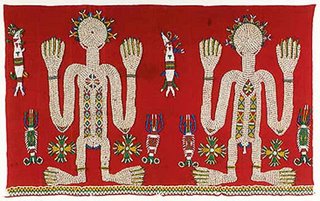
Indonesia, Sumba. woman's ceremonial skirt, about 1900. imported cotton fabric, nassa shells, trade glass beads. Eliza M. and Sara L. Niblack Collection.
INDIANAPOLIS.- The Indianapolis Museum of Art presents the exhibit I Do: The Marriage of Fashion and Art through February 25, 2007. Wedding gowns, veils and other bridal attire and furnishings have been a traditional part of marriage rites in world cultures for hundreds of years. I Do, an exhibition opening June 11 in IMA's new galleries for textile and fashion arts, celebrates these important traditions. Fifteen Western wedding gowns—12 American and three European—will be displayed in the Paul Fashion Arts Gallery, and 30 wedding garments and other nuptial pieces from Asia and Africa will be shown in the Paul Textile Arts Gallery.
The Western gowns range from a silk damask dress made in Boston in 1837 to a Christian Lacroix "Wedding Cake" dress created in the late 1980s. The sumptuous materials used in the gowns include silk satin and silk chiffon, velvet, lace, crepe and taffeta. While some of these dresses were too ornate to be worn for other occasions, many had a life after the wedding, at evening receptions and formal parties.
Bridal attire from Asia and Africa—all made between the late 19th and mid-20th century—includes ensembles from China, a colorful Indonesian wrapper embroidered with shells and beads, several ensembles from India, a kaftan from Morocco, and a bridal skirt and train made by the Ndebele people of southern Africa. Photomurals in this part of the exhibition show how the garments were worn. With their exquisite workmanship, rare and precious materials and rich ornamentation, these wedding garments underscore the importance of the marriage rite in the lives of people everywhere.
The Dorothy and Lee Alig Textile Learning Center—located next to the galleries—will showcase different fabrics and yarns and ways in which they are dyed and treated. Twelve small mannequins display the changes in the silhouettes of dress shapes from the 1770s to the 1960s. This space will allow visitors of all ages the opportunity to touch and to feel the textures of the different fabrics and materials. The Textile Learning Center also includes photomurals and a short video featuring marriage ceremonies from several cultures throughout the world.
15th Biennale of Sydney – Zones of Contact
15th Biennale of Sydney – Zones of Contact : jun, 20, 2006, artdaily.com
SYDNEY, AUSTRALIA.- The 15th Biennale of Sydney – Zones of Contact features 85 artists from 44 countries presenting the most innovative and bold art being made in the world today, on view through August 27. From Circular Quay to Campbelltown, Sydney is transformed with 75 of the international and Australian artists in town to celebrate the opening week. Witness a family become an artwork. Propose marriage to an artist. Hear a 1984 Ford Falcon Station Wagon make music. See Mona Hatoum’s mobile home ‘hung out to dry’.
Alfredo Juan Aquilizan & Maria Isabel Gaudinez-Aquilizan welcome you to follow the journey of their family as they farewell the Philippines and start a new life in Australia. At the Ivan Dougherty Gallery, marvel at the display of all their worldly possessions neatly packed in boxes and contemplate the logistics and emotions of uprooting a life and starting over in a new country.
Looking for love? Speed dating meets politics with JC Decaux’s bus shelter posters that offer a unique proposition to Sydneysiders. Iranian-born, Paris-based artist Ghazel provocatively offers herself in marriage in order to secure an entry visa. Wanted highlights the desperate situation many face in a seemingly borderless world. Curious about how we appear to artists? Fiona Tan’s Vox-Populi, a collection of 100 photographs sourced from Sydney residents is a revealing mass portrait. On display at the Art Gallery of New South Wales, Vox-Populi exposes both our similarities and differences.
Japanese artist Ujino Muneteru plays electrical appliances, drills, turntables, microphones and even a 1984 Ford Falcon Station Wagon to produce industrial beats.
Saadeh explores the oppressive forces impinging on the lives of Palestinian women today, while The Atlas Group investigates the use of car bombs during the 1975-1991 conflict in Lebanon (bookings essential: visit www.sydneyoperahouse.com).
Palestinian artist Mona Hatoum’s politically-charged 2005 exhibition at the Museum of Contemporary Art was a dinner party subject long after it closed. Hatoum’s new work, Mobile Home, revisits the tensions of house and home and features slow-moving objects that signify domestic life and travel.
Enhance your Biennale experience and fuel your passion by soaking up ideas and inspiration at our free events. Hear first-hand about individual works from their creators at Artist Talks; explore in depth the ideas of the Biennale at three Symposia; or attend the interstate program of Masterclasses which take the conversation beyond Sydney and out across Australia.
The Biennale of Sydney always provides an opportunity to see pioneering artworks and exciting artists from around the world. Known for its variety and breadth and its unpredictability, this exhibition is no exception. Zones of Contact takes us far off the well trodden path with artists from diverse places such as the Middle East, the Baltic and Balkan States, Pakistan, China and India. Zones of Contact provides you with an opportunity to explore other cultures and ways of life and travel the world without leaving Sydney. Come along and experience an extraordinary feast of artistic endeavours.
Charles Merewether, Artistic Director & Curator of the 2006 Biennale of Sydney says, “I’ve created a map of the world in terms of artists: links are made, common threads appear and commonalties between people are discovered. I wanted a broad range of artists to show people there is incredible work going on in these countries we know little about. I want people to be moved. I want it to be a celebration where people enjoy the work, learn from it and get excited by it.”
“Charles Merewether has brought together an astonishing range of artists whose works evoke a poignancy rarely encountered in art exhibitions”, says Luca Belgiorno-Nettis, Chairman of the Biennale of Sydney. “It is only with the generous support of our public and private sector partners, both in Australia and overseas, that an event of this magnitude is possible. We look forward to the public being as captivated and inspired as we are by this remarkable exhibition.”
Gustav Klimt Painting Sells For A Record $135 Million
Gustav Klimt Painting Sells For A Record $135 Million : jun, 20, 2006, artdaily.com
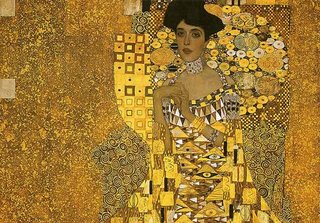
Gustav Klimt, Adele Bloch-Bauer I, 1907. Oil, silver, and gold on canvas. 55 1/8 x 55 1/8 in. (140 x 140 cm). Estate of Ferdinand Bloch-Bauer.
NEW YORK.- Ronald S. Lauder, cosmetics tycoon, billionaire and founder of the New York Museum Neue Galerie, has acquired Gustav Klimt´s Portrait of Adele Block-Bauer I made in 1907. The businessman reportedly paid the highest sum ever paid for a work of art $135 million. Picasso's Boy With a Pipe, which fetched $104.1m (£56.3m) in 2004, holds the record for art sold at auction. “The Klimt sale was subject to a confidentiality agreement but family lawyer Steven Thomas confirmed it had exceeded the Picasso record”, reported the BBC. The portrait was sold by Block-Bauer's niece, Maria Altmann, who was able to claim the painting as hers only this past January, reported Forbes magazine.
Along with this painting, four others were stolen by the Nazis in 1938. “Klimt's 1907 portrait of his patron and rumoured lover was taken in 1938 in the Hermann Goering-led plunder of art by the Nazis. It eventually found its way into the Belvedere Museum in Vienna and was the subject of a rancorous eight year battle between the Austrian government and the heirs of Adele Bloch-Bauer”, reported the Guardian. The paintings were returned to their rightful owners in January and were then thought to cost more than 150 million. The collection has been on display at the Los Angeles County Museum of Art since April and will remain there until June 30.
A press release from the Los Angeles County Museum states: As the leading exponent of Viennese Jugendstil in painting, Klimt’s most memorable works included his dazzling portraits of Vienna’s leading society ladies, many of whom were Jewish. One of the best known of these is his magnificent 1907 painting, Portrait of Adele Bloch-Bauer I, portraying the wife of the industrialist Ferdinand Bloch-Bauer (the aunt of Maria Altmann).
Foremost among the rare “gold style” works, the painting captures its elegant and intelligent subject as the ideal of feminine beauty. The figure dissolves into sumptuous patterning reminiscent of the Byzantine mosaics at Ravenna, Italy, portraying the Empress Theodora, which Klimt had visited in 1903. Klimt’s fine craftsmanship in this work is evident in his varied uses of real gold: as a diffuse background luster reminiscent of Japanese lacquer, as the fabric of a flowing gown, and as a pattern punctuated with Egyptian god’s-eye motifs. In contrast with this rich decorative treatment, Adele’s face stands out as an extraordinarily modern psychological portrayal, while her hands are arranged gracefully to conceal a deformed finger. Self-assured yet introspective, she comports herself as a woman of privilege devoted to the world of the intellect.
Transcending the customary role of women at the time, Adele hosted a salon, a regular social gatherings of artists, writers, musicians, and progressive politicians who discussed the issues of the day.
Adele Bloch-Bauer was the only woman whose portrait was painted twice by Klimt. In Portrait of Adele Bloch-Bauer II the artist abandoned the iconic ambience and gold decoration of the first portrait in favor of a more modern approach to color. The vivid colors are applied spontaneously, yet with a strong compositional sense. An Asian motif can be seen in the upper background.
If you would like to know more about Klimt´s life and important dates in his career please visit: http://www.expo-klimt.com/2.cfm
Monday, June 19, 2006
Public art Public Sculptures
Public art Public Sculptures
By sudhir deshpande
Introduction
Till 15th century, sculptors and artists were under the influence and control of religious power and churches, but there after blind trust in religions and churches were abolished due to scientific inventions. Royal families supported artists and sculptors and they got personal importance and scope for creations. For example Michelangelo’s sculptures like David, Moses, Pieta, day, night, etc. Sculptors got freedom for creations. They were commissioned by royal families to create sculptures to decorate their gardens, tombs, and premises under their control. Many times sculpture or memorials were created to celebrate their victory in war.
In recent times, during 19th century, the world changed due to latest scientific and technical inventions like trains, telegraphs, aircrafts, radio, television etc. Art became important for royal and wealthy families and became a part of luxurious lifestyles. But they were using the art and artists like sculptures for people. Art became public since then, apart from the art used for the churches and temples. People started enjoying art and the types of sculptures. Sculptors were free to use their ideas and experiences, which could fit into the requirements of the commissioners of the art.
Public Art / sculptures.
Public art as objects in our environment for public use and enjoyment that may display the following characters:
Historic
Aesthetic
Functional
Public art can be found in the form of:
Sculpture
Monuments
Murals
Fountains
Amenities such as seating, lights, signs
‘Art’ and ‘the public’ do not belong to different categories or stand for entirely different phenomena. Art is public by definition. Works of art are the result of actions aimed at the public. Metaphorically, the arena of art is a public space. People do not create art without a desire to communicate. All else is a private matter, a hobby, self-fulfillment..In Public places, there are many forms of art that enhance the space and give it character. Sculpture of all kinds can be found in almost any city either representing a historic figure, or expressing a style, thought, or culture. Murals are found on the sides of buildings, or expressing something of cultural, historical, or visual importance. Fountains celebrate the reflections and coolness of water and add white noise, drowning out the sounds of traffic.
The art works exhibited, installed, in public places for public are called public arts. Though, the intention of installing sculpture, normally, is to decorate the area or premises, there can be many more reasons for the same. As a discipline for the traffic, town planners keep traffic circles or round- abouts, to direct and control vehicle traffic. In this traffic circles sculptures are installed. These sculptures are designed by sculptor for the specific site. This is known as site-specific sculpture.
Other place is garden. This can be public garden or private garden. For public garden, decoration of the premises is main intention, but in very rare case the sculpture is designed according to concept. This concept might be related to the subject of sponsor, or the city or the event. Most of the times this can be a monumental sculpture. For example, war memorial, accident memorial, revolutionary movement, freedom movement or to characterize any movement started by a leading personality etc. and when in private garden is to be decorated, the collection with some specific interest can be a reason or to say something or for some statement the sculpture can be installed.In its earliest form, Art in Public places was likely to be a sculptural tribute to the conquering hero in the form of a larger than life statue high upon its grand pedestal. Either placed in a civic plaza by the hero's own people, as a celebration of power and victory of their nation over others, or alternately placed in the victims midst by the victors as a reminder to those conquered of their vulnerability.Now in this modern times, bus station and train stations, airports, traffic junctions etc. are the main location for sculptures. Airport authorities act as the curator and arrange changing exhibitions also. Some particular area, through which passenger traffic is more, is considered for these types of changing exhibitions.
All these public places are used by city or country authorities to install sculptures to show and maintain cultural richness of the institutions. Manchester Airport runs a scheme displaying art works from local artists in their terminals.One can find on the San Francisco Airport which features a great deal of public art ranging from permanently installed paintings to museum style rotating exhibits and more community based shows. It does a great deal because the first impression of the city is that culture and the arts are extremely important. Sets the mood right off.”Art in Public Places was an early attempt by the National or International authority (and other private funders) in providing the public with the "best art" from mainly "best known" artists. This can be a little attempt to incorporate the work into the environment and it's function outside of aesthetic considerations. Public art identifies the city, displaying persons and events in history by use of historic monuments. This form of art can educate the public about these historically important events. They cause people to think about the history, remember the events and people, and even to relive them.Public Art is art that is accessible to any person in public places, e.g. park, city center, etc.
An example of Public Art is, the statue of Saint Teresa placed in Santa Maria, Rome, or Late Indira Gandhi Memorial in New Delhi, or Mahatma Gandhi statue (almost every where) in India or Kutub Minar in Delhi, Tajmahel in Agra, Elephanta and Elora caves in Maharashtra. Public Art has many different moods. The artist is required to provide "Public Art" for the public, but his piece of art comes from whatever mood he is in when he is producing his, art. It could mean different things to different people, but most of the time people will not be able to figure out what that piece of art really means. Public Art (sculptures) are usually owned by buildings or builders or organizations or corporate sectors, around where it is but are put there for the enjoyment of the public.
A public sculpture is a symbolic object in service to the community need. The sculptor and the community, which commissions the work, must collaborate on the creation on the symbol or sculpture and its message communicated by the work.Public art benefits the community, the public, by enhancing the experience, whether it is a walk in the park or an entryway into a city. Our minds are so overloaded with advertising / marketing that public art is a welcome change.Public art identifies the city, displaying persons and events in history by use of historic monuments. This form of art can educate the public about these historically important events. They cause people to think about the history, remember the events and people, and even to relive them.Public art is not a style or a movement, but a compound social service based on the premise that public well-being is enhanced by good art, and that good art means work by advanced artists thrust into the public.Public art often faces more practical obstacles than just popular opinion. Public art usually starts when the city government, an architect or developer decides a building needs a sculpture, and then they choose an artist to create the piece. Public art means comparison-shopping and finding the design to best fit a particular spot. Most importantly, public art must comply with safety regulations. Each city has particular considerations: acid rain and different salts can degrade a sculpture over time, perhaps causing it to weaken and break and fall or leave an unsafe edge.Traditionally the purpose of public art was one of commemorating important personalities and/or events - literally, the narrating of history in the streets. It was believed that through exposure to art and the inculcation of national and local pride the masses would become more cultured and civic-minded .Public art and monuments promote social gathering and interaction. The piece of art usually attracts people closer to the object, and often offers a place to sit, or meet, others. The art automatically becomes an identifiable point in the urban environment. It is in this sense that most works of public art are found in public plaza or parks where the site is more suited for such gathering. Many times, these sites, found in the heart of the city, include monuments that symbolize the history of the place, or fountains and sculpture that demonstrate a celebration of place. These objects are seen as attractions to visitors and local citizens alike.The urban environment can become personalized with art by demonstrating a particular style, activity, or culture. Art creates a sense of place, it reflects social theory about the place, and displays a style that is attributed to the space.
Art is often used in public places to give it character, to make a space interesting, or to simply beautify it. People remember a place because of the artwork that exists in the space - the art acts as a symbol of the place. The Arch in St. Louis is a highly recognized symbol, just as the Statue of Liberty symbolizes New York. Eiffel Tower is the identity of Paris, France and the sculpture ‘Powerful’ (‘Shaktiman’ in Marathi) at Nashik. The name of the area which was Eklahara’ is known as ‘Shaktiman Nagar’. This recognition is a place-making device.Sculpture, memorials, monuments, fountains and murals are placed in public places to display historic meaning, cultural significance, and city beautification. Public plazas offer the pedestrian a place to gather, relax, enjoy the sites, and play. These places often incorporate art, decoration, and landscape features to make the place beautiful and give it character. Art gives the urban area a sense of place.Sometimes public art can stir up controversy in public. In India there are many examples of this problems. And main reasons are the statues installed at the center places, public parks. Though the intentions of creating and installing statues is to respect the ideal social, political or religious personalities, anti-social elements in the society takes undue advantage of the system. These statues, although they are supposed to be inspiration to society, are not well maintained. Not even cleaned regularly. And so-called antisocial elements use them to create havoc and uneasiness in the society so that these evil elements make their own benefit.
In other countries also, there are example like this. Chicago always has been a center for public art, from its vast collection of 1930's WPA murals to the well-publicized 1999 project that brought herds of fiberglass cows to city streets. Michael Lash, Chicago's Director of Public Art, says public art sparks controversy, debate and citizen complaint, but it's also a source of civic pride and identity.This sculpture Picasso donated to Chicago in 1967. At the time, Mayor Daley wanted the world's "most famous artist" to do a sculpture near City Hall, so he sent business leaders and civic leaders to woo Picasso. Picasso never cashed the check he received, making it a gift to the people of Chicago.The "Chicago Picasso" resembles a giant baboon and is one of the most simultaneously loved and hated sculptures in the public eye. "People had not a clue what the sculpture was about and they still don't, because Picasso wouldn't give any clues about its meaning. People would speculate on the inspiration: “was it supposed to be an Afghan hound, the head of a baboon or his mistress Jaclyn?" Lash says.But this situation never remains for long time. Like the Eiffel tower or the St. Louis arch or the Statue of Liberty, at first people are appalled by it but they gradually come to love it and would kill anyone who tried to take it away. They might not really understand the art, but after a while they do understand that these pieces are part of the symbolism of a city. With public art, there is "no entry fee or guard telling you how to behave. That's the best and also the most potentially dangerous thing about public art.
Sunday, June 18, 2006
artdaily.com, 18 jun 2006 : Probable Copy of Mona Lisa in Portland
artdaily.com, 18 jun 2006 : Probable Copy of Mona Lisa in Portland
 Left: Attributed to Leonardo da Vinci (Italy, 1452-1519), La Gioconda, no date. Gift of Henry H. Reichhold. Right: The Real Mona Lisa by Leonardo da Vinci.
Left: Attributed to Leonardo da Vinci (Italy, 1452-1519), La Gioconda, no date. Gift of Henry H. Reichhold. Right: The Real Mona Lisa by Leonardo da Vinci.PORTLAND, ME.- Just in time for the release of the hotly anticipated film The Da Vinci Code, the Portland Museum of Art will display its rarely seen Mona Lisa painting, attributed to Leonardo da Vinci. This enigmatic work, officially titled La Gioconda, is thought to be either a preparatory study for the Mona Lisa by Leonardo himself or a copy painted by one of his followers shortly after the creation of the original, which now resides in the Louvre Museum in Paris.
The painting was given to the Portland Museum of Art in 1983 by Henry H. Reichhold, a summer resident of Prouts Neck, Maine, who purchased the work in the 1960s after the death of its European owner. Subsequently, La Gioconda was analyzed at the Straus Center for Conservation and Technical Studies at Harvard University. Conservators determined that the painting was executed before 1510—the original Mona Lisa was created between 1503 and 1507—but they were unable to confirm or refute Leonardo’s hand in its creation. However, similarities are remarkable, and the work contains the characteristics of a left-handed brushstroke, consistent with Leonardo’s work as a left-handed artist.
Unlike a forgery or counterfeit work, the Museum’s Mona Lisa, on the basis of technical analyses, differs from the original in size, composition of background landscape, and, most notably, the absence of the enigmatic smile–details which suggest an early study rather than a simple reproduction. Regardless of the true authorship of the painting, La Gioconda brings into sharp focus the kinds of problems facing conservators and art historians today, and it is a compelling work of undeniable artistic interest on its own.
Numerous copies of the Mona Lisa exist. From the 16th century through the late 19th century artists traditionally copied acknowledged masterpieces in order to learn more about the stylistic and compositional techniques of the great masters.
artdaily.com, 17 jun 2006 : Monet in Normandy Opens Today at Legion of Honor
artdaily.com, 17 jun 2006 : Monet in Normandy Opens Today at Legion of Honor
 Claude Monet, Port of le Havre, 1874 (also known as View of the Old Outer Harbor at Le Havre). Oil on canvas, 23-3/4 x 40-1/8 inches. Signed lower left: Claude Monet. Philadelphia Museum of Art.
Claude Monet, Port of le Havre, 1874 (also known as View of the Old Outer Harbor at Le Havre). Oil on canvas, 23-3/4 x 40-1/8 inches. Signed lower left: Claude Monet. Philadelphia Museum of Art.SAN FRANCISCO, CA.- The fifty-three splendid impressionist paintings by Claude Monet that are on view in this exhibition are part of the artist’s Norman oeuvre, which defined modern Normandy at the turn of the century not only for the French but also for the world. Monet’s central and enduring artistic relationship with Normandy has never before been the focus of a scholarly exhibition, and Monet in Normandy marks the first comprehensive presentation of this essential aspect of his artistic career.
The paintings in Monet in Normandy were created from the 1860s through the mid-1920s and trace the fullness and complexity of Monet’s “image” of Normandy -- its beaches, villages, rivers, agriculture, and tourist industries, as well as the grandeur and historical importance of its capital city, Rouen. The exhibition culminates with paintings Monet made of the area around Giverny and of his own water gardens at his Giverny home.
The presentation at the Legion of Honor of Monet in Normandy is the first of only three venues for this international exhibition. Following its showing in San Francisco, the exhibition will be on view at the Fine Arts Museums’ organizing partners: the North Carolina Museum of Art, Raleigh, and The Cleveland Museum of Art.
Each of the three organizing museums has made major loans of Norman paintings by Monet to the exhibition. The numerous additional significant lenders include The Metropolitan Museum of Art, New York; the Museum of Fine Art, Boston; The Art Institute of Chicago; the Sterling and Francine Clark Institute, Williamstown; the National Gallery of Art, Washington, D.C.; the Wadsworth Atheneum, Hartford; the Philadelphia Museum of Art, Philadelphia; the National Museum of Western Art, Tokyo; the Musée d’Orsay, Paris; the Musée Malraux, Le Havre; the Staatsgalerie Stuttgart; the Kunsthaus Zurich; and a number of private collectors.
Claude Monet and Normandy: A Lifetime of Sublime Inspiration Claude Monet (1840-1926) was born in Paris but spent most of his life in Normandy. His art reflects his special relationship with this northern countryside and its topographical features, its towns and villages, and the seasonal rhythms of the region. He drew artistic inspiration from these subjects and returned to them throughout his career. Of particular interest is his interpretation of the ephemeral variations of weather, light, and color specific to the Norman countryside, and the sparkling, endlessly shifting bodies of water found in Normandy. Monet made magical images of the bustling commercial harbor at Le Havre, the scenery along the Seine or beside other quiet river banks, such as the Epte, and, most dramatically, the crashing waves at Etretat. Man-made monuments, such as the Rouen Cathedral, also figure in Monet’s repertoire and are represented in Monet in Normandy.
Normandy was the first region of France to be intensively exploited as a site of tourism. Even in the late 18th and early 19th centuries, painters and draftsmen from France and Britain visited its farming communities, fishing villages, and regional cities in search of picturesque, sublime, or historically significant motifs, and Normandy all but dominated the “Voyages pittoresques” of the 1830s. Monet in Normandy demonstrates that Monet was conversant in the pictorial traditions of his native Normandy and was nurtured in its artistic community. The area’s natural scenic beauty provided subjects particularly well-suited to the interests of a painter such as he, who was fascinated by the ephemeral effects of light, atmosphere, time, and season. First transcribing and finally mythologizing the Norman countryside, Monet explored the region’s pictorial natural and man-made motifs.
The exhibition includes paintings from throughout his long career: early works painted along the north coast of Normandy in the 1860s, the “honeymoon” paintings of Trouville painted in 1870; and paintings resulting from his rediscovery of the coast in the 1880s. Paintings from both of Monet’s important pictorial campaigns in Rouen in 1872–1873 and 1891–1893 are also included. In the 1890s, Monet used several iconic motifs of the Norman region—Rouen cathedral, the Seine, grain stacks, and stands of poplars among others—as vehicles for his bold compositional experiments and intensifying chromatic range, and stunning works represent these important subjects. An important group of Monet’s north coast seascapes of the late 1890s are featured as well; they deal with elements of myth and memory in his Norman oeuvre. A number of his sun-drenched field paintings depicting the Giverny environs serve as a counter balance to the breezy seaside images that have, until now, dominated the popular idea of Monet’s Normandy. The inclusion of these works serves to recognize that Giverny is the southern gateway to Normandy from Paris -- and not part of the Ile de France, to which it is often related. The final sequence of canvases in Monet in Normandy showcases subjects of the artist’s own creation: his luminous images of his carefully choreographed water gardens at Giverny, which monopolized his energies until his death in 1926.
Organization and Credit Monet in Normandy was curated by guest curator Professor Richard R. Brettell, University of Texas at Dallas; Dr. David Steel, Curator of European Art, North Carolina Museum of Art, Raleigh; Dr. Lynn Federle Orr, Curator in Charge of European Art, Fine Arts Museums of San Francisco; and Dr. Heather Lemonides, Assistant Curator of Prints and Drawings, The Cleveland Museum of Art. The curatorial team drew on important relationships within FRAME -- French Regional and American Museum Exchange, a unique bilateral consortium that stresses the importance of regional artistic culture -- which made possible direct access to distinguished French scholars, curators, archives, and collections.
Monet in Normandy is organized by the Fine Arts Museums of San Francisco, the North Carolina Museum of Art, Raleigh, and The Cleveland Museum of Art. The exhibition is supported by an indemnity from the Federal Council on the Arts and the Humanities. The presentation in San Francisco is made possible by Bank of America.
Friday, June 16, 2006
Call for Artists: Step into Leonardos Shoes Anatomy Drawing
"Call for Artists: Step into Leonardos Shoes Anatomy Drawing" 2006-06-14 until 2006-07-10 University of New South Wales, School of Medical Sciences Sydney, NS, AU Australia
Want to draw real human anatomy specimens at the University of New South Wales, Sydney? Once again the School of Medical Sciences in the Faculty of Medicine is offering the opportunity to draw specimens under the guidance of anatomist Associate Professor Brian Freeman and artist Susan Dorothea White, author of Draw Like Da Vinci. Discover what's under the skin, gain a greater understanding of the human form and acquire new drawing skills at the five-day workshop, from the 10th to 14th of July 2006.
Embalmed specimens (blood-free) are displayed on stainless steel benches in a spacious, well-lit university laboratory; you draw at your own pace. Personalised instruction is provided in an informal atmosphere, and all levels are welcome, from beginners to professionals. Cost AUD490. Places are limited – email m.kwok@unsw.edu.au for further information/registration. Step Into Leonardo's Shoes Anatomy Drawing WorkshopJuly 10-14, 2006School of Medical Sciences, University of New South WalesSydney, AustraliaPh (61 2) 9385 2480www.leonardosshoes.com
Klee and America at the Phillips Collection
 Paul Klee, Sunset, 1930.209. Oil on canvas. The Art Institute of Chicago, Gift of Mr. and Mrs. Leigh B Block. ©2006 Artists Rights Society (ARS), New York / VG Bild-Kunst, Bonn. Photo © The Art Institute of Chicago.
Paul Klee, Sunset, 1930.209. Oil on canvas. The Art Institute of Chicago, Gift of Mr. and Mrs. Leigh B Block. ©2006 Artists Rights Society (ARS), New York / VG Bild-Kunst, Bonn. Photo © The Art Institute of Chicago.Klee and America at the Phillips Collection
WASHINGTON, DC.- German artist Paul Klee (1879–1940) was one of Europe’s most internationally esteemed artists when the Nazi regime condemned his art in the early 1930s. At the same time, admiration for Klee swelled in America as his works increasingly entered the collections of major museums and private collectors. From June 17 to Sept. 10, 2006 at The Phillips Collection, America’s first museum of modern art, Klee and America will explore the rise of Klee’s American success and artistic legacy from the 1920s through the 1950s. It will reveal the reasons behind the enthusiasm for Klee in the United States, which provided not only his most attentive audience but also a safe haven for his theories of artistic freedom, self-invention, and authenticity. Unlike other European modern artists, Klee was never enraptured with American popular culture. By the same token, Americans remained largely dispassionate about the work of Swiss-born Klee when it was first introduced to the United States in the 1920s. By the end of the decade, only two major private Klee collectors existed in the country, Galka Scheyer in California and Katherine Dreier in New York. In 1924, critic Henry McBride underscored the enigmatic nature of Klee’s work, describing him as “that strange meteor from Switzerland” on the pages of the New York Herald. By 1930, when his art was being purged from the Schlossmuseum in Weimar, Germany, Klee’s reputation in America had already started to spread. His work was celebrated in Alfred Barr’s 1930 retrospective at the Museum of Modern Art in New York, the first one-person exhibition ever given to a living European artist at the museum. Throughout the 1930s and 1940s, American collectors increasingly pursued Klee’s art, seeking works in greater quantities and of major significance. Today, more than ten percent of Klee’s entire output (approximately 1,150 works) resides in U.S. collections. Klee and America will investigate the long and complex history of Klee’s reception in the U.S. from the 1920s to 1950s, and the lasting influence of his work on American artists of the mid-20th century. Comprising some 80 works, the exhibition will explore why American collectors–including The Phillips Collection’s founder, Duncan Phillips–were attracted to Klee’s work, and how it came to be championed by the abstract expressionists of the 1940s and 1950s. It will open in conjunction with the focus exhibition When We Were Young: New Perspectives on the Art of the Child, which will feature contemporary children’s drawings alongside several historical childhood drawings by Klee and Pablo Picasso. “Duncan Phillips was a major believer in and collector of Klee’s works, even dedicating a room of the museum to the thirteen that he owned—all of which will be on view during the exhibition,” said Jay Gates, director. “Phillips recognized Klee as ‘a dreamer, a poet, and a brooding rebel…. No art can be more personal than the art of Klee.’ Today, The Phillips Collection continues its commitment to his artistic genius.” Klee and America is organized by The Menil Collection, Houston, Texas, where it received significant support from Altria Group, Inc. KLEE AND AMERICA - In the 1920s, Klee was well known throughout Germany and France as a leading figure of the European modernist movement. While the American media barely mentioned him, in Paris the pages of Broom and Vanity Fair heralded him as one of the fathers of dada and surrealism. By 1921, Klee was the subject of numerous publications and exhibitions throughout Germany, including a major retrospective at the Galerie Hans Goltz in Munich in 1920. He was also appointed to a teaching position at the Bauhaus school in Germany in 1921. Although a few years earlier he was considered one of Germany’s most highly respected artists, by 1933 Klee had been censured by Hitler’s Nazi regime as part of its campaign to stop the so-called “corruption of art,” and the market for his work collapsed in Europe. The National Socialist Society for German Culture dismissed Klee from the teaching position he had held at Düsseldorf Academy since 1931. He fled to Switzerland in 1933, but the Nazis still included 17 of his works in their “Degenerate Art” exhibition of 1937. Nazi Germany may have undermined Klee’s career and uprooted him from his job and home, but it did not distance him from his values. One reason why Klee appealed to American collectors and creators is that his life and works largely mirror American ideals. He was considered a revolutionary artist rebelling against a domineering nation, insisting on preserving his freedom of expression even in an increasingly oppressive environment. Though created on small canvases, Klee’s works shattered artistic conventions. Klee liberated artists from the grid of cubist space, infusing his work with a highly lyrical form of expression. Over time, he developed a powerful abstract language of signs that drew upon ancient sources as well as the energetic line drawings of children. The first Klee work acquired by the Phillips, Tree Nursery (1929), is divided into horizontal bands of color within a textured field of paint. By interweaving circles, triangles, and tree forms, Klee creates a lively inscribed text that resembles both a series of pictograms as well as the structure of musical polyphony. Drawing upon aesthetic design principles associated with the Bauhaus—and his own background as an accomplished violinist—Klee added to the emotional intensity in his work by expressing the visual analogies between art, architecture, and music. In Cathedral (1924), Klee uses delicate white lines to map the cathedral’s bays, windows, and crenellations onto a grid-like field, suggesting an architectural plan or elevation. At the far right edge of the panel, the lines become musical notations, evoking the harmonies of a choral song rising from a house of worship. Young Moe (1938) represents not only Klee’s love of music, but also his fascination with unusual materials. Rendered with colored paste applied to newspaper on burlap, the work pays homage to Albert “Moe” Moeschinger, professor of music theory at the conservatory of Bern from 1937 to 1943, who had dedicated three compositions to Klee in 1935. In this abstract composition, swirling black lines flow on top of shifting fields of color, implying a sense of rhythm and melody. Klee’s vast thematic and stylistic range appealed to American artists of the 1930s, 1940s, and 1950s wanting to escape the limitations of geometric abstraction and surrealism. A central figure in America’s embrace of the European avant-garde, Klee contributed significantly to what is now considered the essence of American art. In particular, Klee’s work was a major source of inspiration to the abstract expressionists, including Mark Tobey, Adolph Gottlieb, and Kenneth Noland. Other second-generation American modernists, such as Richard Diebenkorn and Alexander Calder, also cited Klee as having had a profound impact on their art. Increasing interest in and collection of Klee’s works in the United States during the first half of the 20th century may explain his assimilation into American culture that continues today. At the latest Klee retrospective, held in 1987 at New York’s Museum of Modern Art, critic John Russell asserted that Klee’s influence was so pervasive that it would be difficult to pass a day in the city and not be reminded of his manner of signifying bodies and faces, his floating arrows and initials, and his shorthand architectures. "The legacy of Klee is everywhere," he said.
Frida Kahlo at Bucerius Kunst Forum
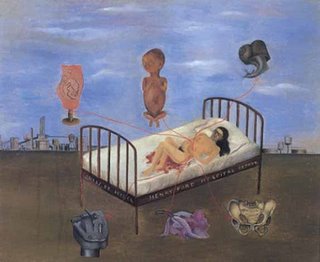 Frida Kahlo, Henry Ford Hospital, 1932. Oil on metal, 31 x 38,5 cm. Museo Dolores Olmedo Patiño, Xochimilco, Mexico.
Frida Kahlo, Henry Ford Hospital, 1932. Oil on metal, 31 x 38,5 cm. Museo Dolores Olmedo Patiño, Xochimilco, Mexico.Frida Kahlo at Bucerius Kunst Forum
HAMBURG, GERMANY.-The Mexican painter Frida Kahlo (1907–1954) is the focus of this year’s summer exhibition at the Bucerius Kunst Forum, located on the Rathausmarkt in Hamburg. Through September 17, 34 paintings, drawings and watercolors by this famous artist, representing all her creative periods, will be displayed. Since not a single one of Frida Kahlo’s works is owned by a museum in Germany, this is the first opportunity in more than 10 years to view her art in the original. In 1939, an unknown Mexican painter appeared on the stage of the Paris art scene. Surrealists enthusiastically admitted her to their ranks, believing they had discovered a type of Surrealism that had developed entirely independently of their own. Kahlo allowed everyone to believe this, saying, “I had no idea that I was a surrealist painter.” It goes without saying that Frida Kahlo’s pictorial world cannot be understood without knowing something of her biography. Her serious accident, her complex relationship to her husband, the famous muralist Diego Rivera, her numerous affairs, her heartfelt attachment to Mexican traditions and her political involvement all left their marks on Frida Kahlo’s art. As a testament to her suffering and passion, her unconventional spirit and her rebellious sense of humor, her work allowed Frida Kahlo to become one of the most colorful personalities of the 20th century. Nevertheless, Kahlo’s life’s work is much more than the sum total of a fascinating life. Frida Kahlo’s fantastically heightened realism, her unsettling combination of motifs and her collage techniques are closely related to the international artistic developments of her time, which include Dadaism, Neue Sachlichkeit (New Objectivity), Pittura Metafisica (Metaphysical Painting) and Surrealism. Frida Kahlo was well acquainted with these artistic movements: During the years she spent in the USA (1930–1933), she had contact to important artists, museum directors and gallery owners; she visited landmark exhibitions and owned important art catalogs. The exhibition at the Bucerius Kunst Forum shows to what extent Kahlo’s interest in European avant-garde art inspired her own painting. Around 20 works – including paintings by Max Beckmann, Giorgio de Chirico, Otto Dix, Max Ernst, George Grosz, René Magritte, Meret Oppenheim and Christian Schad – demonstrate for the first time the international context in which Frida Kahlo painted, thereby opening new insights into this Mexican artist’s work. Today, Kahlo’s art is a part of Mexico’s National Heritage and in accordance with the wishes of her husband, Diego Rivera, her paintings may never leave the Frida Kahlo Museum in Mexico. With the famous Dolores Olmedo Patiño collection, the Bucerius Kunst Forum has brought the largest private collection of Frida Kahlo’s works back to Germany for the first time since 1993 in the year before Kahlo’s 100th birthday.
(from artdaily.com)
